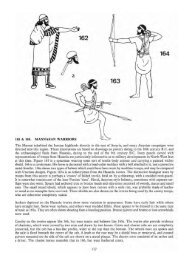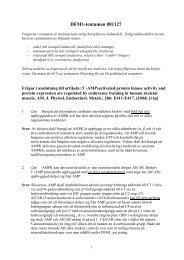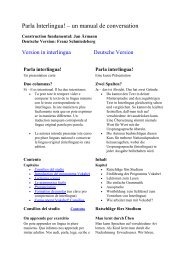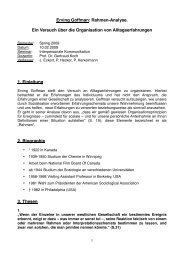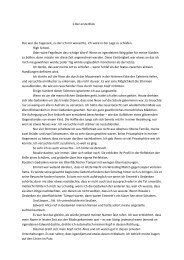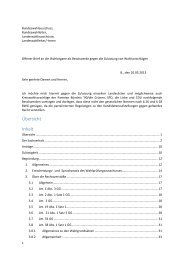lwIP - A Minimal TCP/IP implementation - Wikia
lwIP - A Minimal TCP/IP implementation - Wikia
lwIP - A Minimal TCP/IP implementation - Wikia
You also want an ePaper? Increase the reach of your titles
YUMPU automatically turns print PDFs into web optimized ePapers that Google loves.
12 APPLICATION PROGRAM INTERFACE<br />
computations since <strong>TCP</strong>/<strong>IP</strong> processing cannot occur in parallel with the computation, thus degrading<br />
communication performance. This can be overcome by splitting the application into two<br />
parts, one part dealing with the communication and one part dealing with the computation. The<br />
part doing the communication would then reside in the <strong>TCP</strong>/<strong>IP</strong> process and the computationally<br />
heavy part would be a separate process. The <strong>lw<strong>IP</strong></strong> API presented in the next section provides a<br />
structured way to divide the application in such a way.<br />
12 Application Program Interface<br />
Due to the high level of abstraction provided by the BSD socket API, it is unsuitable for use in<br />
a minimal <strong>TCP</strong>/<strong>IP</strong> <strong>implementation</strong>. In particular, BSD sockets require data that is to be sent to<br />
be copied from the application program to internal buffers in the <strong>TCP</strong>/<strong>IP</strong> stack. The reason for<br />
copying the data is that the application and the <strong>TCP</strong>/<strong>IP</strong> stack usually reside in different protection<br />
domains. In most cases the application program is a user process and the <strong>TCP</strong>/<strong>IP</strong> stack resides<br />
in the operating system kernel. By avoiding the extra copy, the performance of the API can be<br />
greatly improved [ABM95]. Also, in order to make a copy, extra memory needs to be allocated<br />
for the copy, effectively doubling the amount of memory used per packet.<br />
The <strong>lw<strong>IP</strong></strong> API was designed for <strong>lw<strong>IP</strong></strong> and utilizes knowledge of the internal structure of <strong>lw<strong>IP</strong></strong><br />
to achieve effectiveness. The <strong>lw<strong>IP</strong></strong> API is very similar to the BSD API, but operates at a slightly<br />
lower level. The API does not require that data is copied between the application program and<br />
the <strong>TCP</strong>/<strong>IP</strong> stack, since the application program can manipulate the internal buffers directly.<br />
Since the BSD socket API is well understood and many application programs have been written<br />
for it, it is advantageous to have a BSD socket compatibility layer. Section 17 presents the BSD<br />
socket functions rewritten using the <strong>lw<strong>IP</strong></strong> API. A reference manual of the <strong>lw<strong>IP</strong></strong> API is found in<br />
Section 15.<br />
12.1 Basic concepts<br />
From the application’s point of view, data handling in the BSD socket API is done in continuous<br />
memory regions. This is convenient for the application programmer since manipulation of data<br />
in application programs is usually done in such continuous memory chunks. Using this type of<br />
mechanism with <strong>lw<strong>IP</strong></strong> would not be advantageous, since <strong>lw<strong>IP</strong></strong> usually handles data in buffers<br />
where the data is partitioned into smaller chunks of memory. Thus the data would have to be<br />
copied into a continuous memory area before being passed to the application. This would waste<br />
both processing time and memory since. Therefore, the <strong>lw<strong>IP</strong></strong> API allows the application program<br />
to manipulate data directly in the partitioned buffers in order to avoid the extra copy.<br />
The <strong>lw<strong>IP</strong></strong> API uses a connection abstraction similar to that of the BSD socket API. There are<br />
very noticeable differences however; where an application program using the BSD socket API need<br />
not be aware of the distinction between an ordinary file and a network connection, an application<br />
program using the <strong>lw<strong>IP</strong></strong> API has to be aware of the fact that it is using a network connection.<br />
Network data is received in the form of buffers where the data is partitioned into smaller chunks<br />
of memory. Since many applications wants to manipulate data in a continuous memory region, a<br />
convenience function for copying the data from a fragmented buffer to continuous memory exists.<br />
Sending data is done differently depending on whether the data should be sent over a <strong>TCP</strong><br />
connection or as UDP datagrams. For <strong>TCP</strong>, data is sent by passing the output function a pointer<br />
to a continuous memory region. The <strong>TCP</strong>/<strong>IP</strong> stack will partition the data into appropriately<br />
sized packets and queue them for transmission. When sending UDP datagrams, the application<br />
program will to explicitly allocate a buffer and fill it with data. The <strong>TCP</strong>/<strong>IP</strong> stack will send the<br />
datagram immediately when the output function is called.<br />
16





